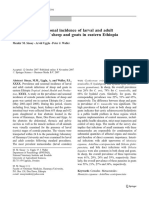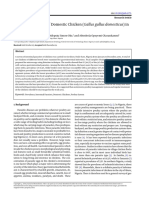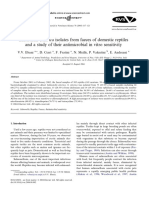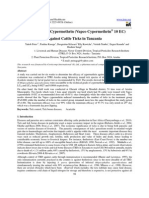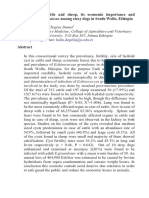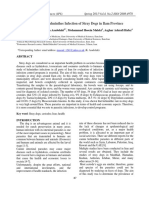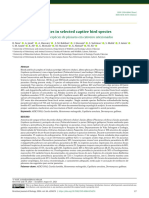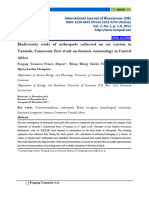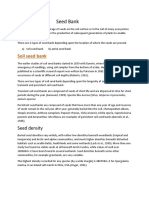Eimeria: Species in Wild Rabbits (Oryctolagus Cuniculus) in Fars Province, Iran
Eimeria: Species in Wild Rabbits (Oryctolagus Cuniculus) in Fars Province, Iran
Uploaded by
Eydo Putra RakhmawanCopyright:
Available Formats
Eimeria: Species in Wild Rabbits (Oryctolagus Cuniculus) in Fars Province, Iran
Eimeria: Species in Wild Rabbits (Oryctolagus Cuniculus) in Fars Province, Iran
Uploaded by
Eydo Putra RakhmawanOriginal Title
Copyright
Available Formats
Share this document
Did you find this document useful?
Is this content inappropriate?
Copyright:
Available Formats
Eimeria: Species in Wild Rabbits (Oryctolagus Cuniculus) in Fars Province, Iran
Eimeria: Species in Wild Rabbits (Oryctolagus Cuniculus) in Fars Province, Iran
Uploaded by
Eydo Putra RakhmawanCopyright:
Available Formats
470
Tropical Biomedicine 27(3): 470475 (2010)
Eimeria species in wild rabbits (Oryctolagus cuniculus)
in Fars province, Iran
Razavi, S.M.
1*
, Oryan, A.
1
, Rakhshandehroo, E.
1
, Moshiri, A.
2
and Mootabi Alavi, A.
1
1
Department of Pathobiology,
2
Department of Clinical Studies, School of Veterinary Medicine;
Shiraz University, Shiraz, Iran
Corresponding author email: mrazavi@shirazu.ac.ir
Received 30 March 2010; received in revised form 1 July 2010; accepted 8 July 2010
Abstract. This investigation was accomplished during February to November 2008. A
total of 71 wild rabbits (Oryctolagus cuniculus) of about 5 to 12 months age were
collected alive from different parts of Fars province, south of Iran. Faecal sampling was
carried out directly from recti and the oocysts were isolated using sedimentation and
floatation techniques and the sporulated oocyst were identified based on morphological
and biological characteristics. All the rabbits were apparently healthy and showed no
clinical symptoms. Twenty two rabbits (31.0%) were positive for infection with Eimeria
and six species including Eimeria perforans (18.3%), Eimeria magna (16.9%), Eimeria
media (14.1), Eimeria irresidua (11.2%), Eimeria flavescens (4.2%), and Eimeria coecicola
(2.8%) were identified. Eighty six percent of the infected rabbits showed mixed infections
with two or three Eimeria species. Lack of clinical signs could be due to the agro
ecological and environmental conditions of rabbit habitats specifically dry and hot
climatic features in recent years. In addition, immunity induced by long term exposure
to low doses of oocysts shedded by the carrier animals probably have pivotal role in
impairing parasitic developmental cycles and preventing acute coccidiosis.
INTRODUCTION
Coccidioses of rabbits are ubiquitous
infections caused by obligatory intra-
cellular protozoan parasites belonging to
the genus Eimeria and considered as
major causes of significant morbidity and
mortality (Lebas et al., 1986; Wang & Tsai,
1991; Coudert et al., 1995; Bhat et al.,
1996). Except Eimeria stidae that invades
the hepatobiliary epithelial cells and is the
causative agent of hepatic lesions, fourteen
other species of Eimeria have been found
to develop in the intestinal tract of rabbit
(Bhat et al., 1996; Taylor et al., 2007).
Mixed infections are common and
generally more than one species of
Eimeria often parasitize the intestinal
epithelium of rabbits (Toula & Ramadan,
1998). The consequences of these
conditions could result in overwhelming
diseases that may coincide with economic
losses in rabbit rearing industries. As a
result, regional identification of different
Eimeria species may enhance control and
preventive strategies.
To date, very few parasitological and
epidemiological studies have been
conducted to identify different Eimeria
species in wild rabbits (Oryctolagus
cuniculus). Thus, the purpose of the
present study is to investigate the
prevalence of different Eimeria species in
the southern region of Iran. Undoubtedly,
the results will increase existing
knowledge on the host-parasite
relationship and help future studies on the
life cycle and detailed structural analysis
of the changes evinced by the
pathogenicity of Eimeria species in rabbit.
471
MATERIALS AND METHODS
Animals
A total of 71 adult (approximately 5-12
months old) wild rabbits (O. cuniculus),
were collected alive from crop (particularly
alfalfa) fields, in different parts of Fars
province, south of Iran during February to
November 2008. The average annual
relative temperature of Fars Province,
southern Iran was 22.2C, its average
annual relative humidity was 38.2%, and
annual rain fall was 185 mm (Iran
Meteorological Organization. www.irimo.
ir). The animals had not been treated by any
anti parasitic or anti coccidian drugs (such
as coccidiostats) prior to sampling.
Faecal examination
Faecal samples were collected directly
from the recti and transferred into
parasitology laboratory. A suspension of
each sample (3 gr per 30 ml water) was
strained through a sieve and resulted
filtrate subjected to the centrifugal
sedimentation (Bhat & Jithendran, 1995).
To isolate the oocysts of Eimeria, the
sediments were examined by centrifugal
flotation with saturated sugar solution
(Ming-Hsien & Hong-Kean, 2008). The
collected oocysts were transferred into
2.5% aqueous potassium dichromate
solution (w/v) and incubated at 25-28C for
168 hours to allow the oocysts to sporulate
and examined periodically to determine
mean sporulation time. The morphological
features of sporulated oocysts including
shape, shape index, size, inner and outer
wall, micropyle and residium were
measured and the identity of the parasites
was determined by the keys previously
described by Pellerdy (1974), Catchpole &
Norton (1979) and Levine (1985).
RESULTS AND DISCUSSION
The morphological characteristics of
sporulated oocysts isolated from a total of
71 collected faecal samples are presented
in Table 1.
The present study revealed that 22
rabbits (31.0%) including 8 males (36.3% of
infected animals) and 14 females (63.7% of
infected animals) were infected with
Eimeria oocysts. Six species of Eimeria
including Eimeria perforans, Eimeria
magna, Eimeria media, Eimeria
irresidua, Eimeria flavescens, and
Eimeria coecicola (Fig. 1) were isolated
from the examined rabbits. The prevalence
rate of different Eimeria species is showed
in Table 2. Eimeria perforans, E. magna
and E. media generally showed the higher
prevalence rates, respectively, whereas E.
irresidua had less prevalence and E.
flavescens and E. coecicola showed
relatively low percentage of infection.
Furthermore, mixed infection with two or
three species was the most frequent criteria
and occurred in 86% of the infected
samples.
Eimerial infections have a worldwide
distribution and are prevalent in a wide
range of animals (Levine, 1988).
Coccidiosis in rabbits is highly contagious
sporozoal infection that occurs by oral
ingestion of oocysts along with infected
food and water (Pellardy, 1974; Bhat et al.,
1996). Fifteen specific rabbit-infecting
Eimeria species have been demonstrated
as yet (Bhat et al., 1996; Taylor et al., 2007)
that are usually found in different
anatomical regions of the intestinal
epithelium of rabbit (Ming-Hsien & Hong-
Kean, 2009). Concurrent or mixed
infections by several Eimeria species often
occur in rabbit intestine and is regarded as
a usual finding (Levine, 1985). Present
study showed a high percentage (86%) of
mixed infection that is in accordance with
those of the previous studies (Catchpole &
Norton, 1979; Levine, 1985).
There are very few published data on
the prevalence rate of Eimeria infection
in wild or domestic rabbits. The present
study demonstrated a significantly lower
prevalence rate of infection (31%) in south
of Iran compared to the results of similar
studies in India, France and New Zealand
in which a higher prevalence rate ( more
than 50%) were reported (Bhat et al., 1996;
472
Table 1. Morphologic characteristics of six Eimeria species identified in wild rabbits (Oryctolagus
cuniculus) from south of Iran
Mean
sporulation
time (h)
36
52
36
48
56
62
Sporozoite
size
(m)
4.8 9.6
x
3.8 6
(8.5 x 4.7)
12 16.8
x
6 9.6
(15.3 x 8.6)
9.5 16.8
x
4.8 7.2
(13.1 x 6.9)
12.8 16.8
x
7.2 10.8
(15.1 x 9.3)
14.4 21.6
x
7.3 10.6
(17.9 x 8.7)
15.6 16.2
x
2.8 8.2
(16.3 x 6.8)
Residuum
(m)
3.6 4.8
(4.2)
9.6 14.4
(11.6)
4.8 7.2
(6.2)
3.6 6
(5.3)
Micropyle
+
+
+
+
+
Wall color
Colorless
to pink
Yellowish
brown
Light pink
Yellow
Yellowish
brown
Yellowish
brown
Shape
index
1.21 1.79
(1.56)
1.34 1.52
(1.46)
1.45 1.71
(1.63)
1.46 1.92
(1.53)
1.42 1.93
(1.54)
1.46 2.12
(1.77)
oocyst
Size (m)
14.4 28.8
x
12 21.6
(21.3 x 14.1)
28.8 38.4
x
16.8 28.8
(35.1 x 23.9)
19.2 36
x
14.4 21.6
(29.7 x 18.3)
26.4 36
x
14.4 22.8
(31.6 x 18.9)
34.8 40.8
x
19.2 26.4
(37.2 x 23.8)
25 38.4
x
15.6 21.6
(34.1 x 18.7)
Shape
Ovoid
Ovoid
Ovoid to
ellipsoidal
Ovoid
Ellipsoidal
Ellipsoidal
(cylindrical)
or ovoid
Table 2. Prevalence rates of six Eimeria species (%) identified in faecal samples of
infected wild rabbits (Oryctolagus cuniculus) from south of Iran
Eimeria species
No. of infected Prevalence
animals (% of total samples)
E. perforans 13 18.3
E. magna 12 16.9
E. media 10 14.1
E. flavescens 08 11.2
E. irresidua 03 04.2
E. coecicola 02 02.8
Gurpata & Khahra,1997; Gres et al., 2003;
Yakhchali & Tehrani, 2007). Thus, it can be
stated that some limiting factors are
responsible for the lower prevalence rate
of coccidiosis among the rabbits of this
country compared to those of other
countries. This difference is likely
attributed to the variations in agro-ecology,
meteorology, and environmental conditions
prevailing in each region. Harcourt-Brown
473
Figure 1. Sporulated oocysts of Eimeria isolated from infected samples of wild rabbits
(Oryctolagus cuniculus) from south of Iran. (1) E. perforans, (2) E. magna, (3) E. media, (4) E.
irresidua, (5) E. flavescens, and (6) E. coecicola (x 1500 except for No 2, x1000)
474
(2004) stated that oocysts can survive for
a long time in the humid environment
but they are susceptible to dry conditions.
The average annual relative temperature
of Fars Province, southern Iran is 22.2C,
its average annual relative humidity is
38.2%, and annual rain fall is 185 mm
(Iran Meteorological Organization.
www.irimo.ir). These dry and warm
meteorological conditions are not suitable
for supporting the Eimeria life cycle in
wild rabbits of this area. Similarly, a lower
prevalence of coccidiosis in dry conditions
has been reported for ruminant coccidiosis
(Regassa et al., 2006). Therefore, it can be
speculated that the dry conditions of the
study area (drought), particularly in recent
years with a low rain fall, is an important
factor for not only reducing the infection
rate but also preventing acute coccidiosis
in wild rabbits. However, cecotrophy or
coprophagia, that is a peculiar habit of
rabbits to gain access to vitamins and
proteins synthesized in the large intestine,
could keep infection for a longer time in the
flock and could promote spread of
coccidiosis toward the population and it is
considered a possible important route in the
establishment of cocciosis in healthy rabbit
from the infected ones (Pellerdy, 1974;
Harcourt-Brown, 2004). In addition, the
adult infected rabbits, which are usually
symptomless, act as potential carriers
within the free environment and transmit a
continuous low-grade dose of oocysts to
other rabbits particularly the younger ones
(Wang & Tsai, 1991; Bhat et al., 1996). The
low dose of contaminated oocysts similar
to an attenuated organism in the vaccines
activates the immune system of the newly
infected animals and consequently they
become protected by this acquired
immunity. Thus, it seems rabbit acquires a
durable and effective mucosal rather than
systemic immunity to intestinal coccidiosis
that protect animal to new infections prior
to a severe infection (Pellerdy, 1974; Bhat
et al., 1996).
From different Eimeria species present
in the rabbits of the present study, some
species including E. flavescens and E.
intestinalis are regarded as highly
pathogenic organisms and may have lead
to haemorrhagic enteritis in rabbits
(Catchpole & Norton, 1979; Bhat et al.,
1996; Ming-Hsien & Hong-Kean, 2009). The
results of the present study showed that E.
stiedae, the causative agent of hepatic
coccidiosis and one of the most important
and well-known species of Eimeria in
rabbits (Wang & Tsai, 1991; Bhat et al.,
1996; Al-Rukibat et al., 2001; Gres et al.,
2003; Al- Mathal, 2008) was not found in
this area.
Although the rabbits in the present
study had no clinical manifestations,
presence of highly pathogenic species
indicates that any weather alterations such
as sudden heavy rain fall or occurrence of
immune deficient diseases may act as risk
factors for establishing rabbit coccidiosis
in this area. Furthermore, any national
program for saving the generation of these
animals and keeping them under intensive
rearing system needs more attention to
hygienic measures for controlling rabbit
coccidiosis.
REFERENCES
Al-Mathal, E.L. (2008). Hepatic coccidiosis
of the domestic rabbit Oryctolagus
cuniculus domesticus in Saudi Arabia.
World Journal of Zoology 3: 3035.
Al-Rukibat, R.K., Irizarry, A.R., Lacey, K.,
Lazacos, K.R., Storandt, S.T. & Denicola,
D.B. (2001). Impression smears of liver
tissue from a rabbit. Veterinary
Clinical Pathology 30: 5761.
Bhat, T.K. & Jithendran, K.P. (1995).
Eimeria magna: The effect of varying
inoculum size on the course of infection
in Angora rabbits. World Rabbit
Science 3: 163165.
Bhat, T.K., Jithendran, K.P. & Kurade, N.P.
(1996). Rabbit coccidiosis and its
control: a review. World Rabbit Science
4: 3741.
Catchpole, J. & Norton, C.C. (1979). The
species of Eimeria in rabbits for meat
production in Britain. Parasite 79: 249
257.
475
Ming-Hsien, L. & Hong-Kean, O. (2008).
Effects of chromium compounds on
sporulation of Eimeria piriformis
oocysts. Experimental Animals 57:
7983.
Pellardy, L.P. (1974). Coccidia and
coccidiosis. 2
nd
edition. Verlag Paul
Parey, Berlin and Hamburg, pp, 448
449.
Regassa, F., Sori, T., Dhuguma, R. & Kiros,
Y. (2006). Epidemiology of gastro-
intestinal parasites of ruminants in
western Oromia, Ethiopia. Inter-
national Journal of Applied Research
in Veterinary Medicine 4: 5157.
Taylor, M.A., Coop, R.L. & Wall, R.L. (2007).
Veterinary parasitology, 3
rd
edition.
Blackwell Publishing Company pp,
901902.
Toula, F.H. & Ramadan, H.H. (1998). Studies
on coccidia species of genus Eimeria
from domestic rabbit (Oryctolagus
cuniculus domesticus) in Jeddah,
Saudi Arabia. Journal of Egyptian
Society of Parasitology 28: 691698.
Wang, J.S. & Tsai, S.F. (1991). Prevalence
and pathological study on rabbit
hepatic coccidiosis in Taiwan.
Proceedings of the National Science
Council, Republic of China Part B: Life
Sciences 15: 240243.
Yakhchali, M. & Tehrani, A.A. (2007).
Eimeriidosis and pathological findings
in New Zealand white rabbits. Journal
of Biological Science 7: 14881491.
Coudert, P., Licois, D. & Drouet-Viard, F.
(1995). Eimeria species and strains of
rabbits. In: Eckert, J., Braun, R., Shirley,
M.W., Coudert, P. (Ed.), Guidelines on
Techniques in Coccidiosis Research,
COST 89/820: Biotechnology. European
Commission, Luxembourg, pp. 5273.
Gres, V., Voza, T., Chabaud, A. & Landau, I.
(2003). Coccidiosis of the wild rabbit
(Oryctolagus cuniculus) in France.
Parasite 10: 5157.
Gurpata, S. & Khahra, S.S. (1997). Incidence
of rabbit coccidian in Punjab state.
Veterinary Parasitology 11: 710.
Harcourt-Brown, F. (2004). Textbook
of rabbit medicine, 3
rd
edition.
Butterworth Heineman, Alden Press,
Oxford, pp. 282283.
Iran Meteorological Organization.
www.irimo.ir
Lebas, F., Coudert, P., Rouvier, R. & De
Rochambeau, H. (1986). The rabbit:
husbandry, health and production.
Animal Production and Health, Vol. 20,
FAO (Ed.), Rome, pp. 118127.
Levine, N.D., 1988. The protozoan phylum
Apicomplexa. CRC Press, Boca Raton,
Florida, pp. 351355.
Levine, N.D. (1985). Veterinary proto-
zoology, 1
st
edition. Iowa State
University Press, pp.171179, 221222.
Ming-Hsien, L. & Hong-Kean, O. (2009).
Faecal occult blood manifestation of
intestinal Eimeria spp. infection in
rabbit. Veterinary Parasitology 161:
327329.
You might also like
- 73819-Article Text-165365-1-10-20120216Document8 pages73819-Article Text-165365-1-10-20120216Nissa SissariNo ratings yet
- 132-Article Text-206-1-10-20201214Document6 pages132-Article Text-206-1-10-20201214Emmanuel ogenyiNo ratings yet
- Prevalence of GastroDocument9 pagesPrevalence of GastroGanga BandaraNo ratings yet
- Analysis of Ectoparasites and Gastrointestinal Parasites of Chickens in Modern Farms of The City of KorhogoDocument8 pagesAnalysis of Ectoparasites and Gastrointestinal Parasites of Chickens in Modern Farms of The City of KorhogoOpenaccess Research paperNo ratings yet
- JURNALPIV Dikonversi PDFDocument10 pagesJURNALPIV Dikonversi PDFrara irbahNo ratings yet
- Review of Forensically Important Entomological Specimens in The Period of 1972 - 2002Document8 pagesReview of Forensically Important Entomological Specimens in The Period of 1972 - 2002sinistergripNo ratings yet
- Review of Forensically Important Entomological Specimens in The Period of 1972 - 2002Document8 pagesReview of Forensically Important Entomological Specimens in The Period of 1972 - 2002sinistergripNo ratings yet
- Occurrence of Parasites in Domestic DucksDocument9 pagesOccurrence of Parasites in Domestic DucksOtis MelbournNo ratings yet
- Studies On Prevalence of Ixodid Ticks Infesting Cattle and Their Control by Plant ExtractsDocument11 pagesStudies On Prevalence of Ixodid Ticks Infesting Cattle and Their Control by Plant ExtractsIOSRjournalNo ratings yet
- Prevalence of Gastrointestinal Parasites of Sheep and Goats in and Around Rawalpindi and Islamabad, PakistanDocument5 pagesPrevalence of Gastrointestinal Parasites of Sheep and Goats in and Around Rawalpindi and Islamabad, PakistanKrisztike VargaNo ratings yet
- Ajol File Journals - 334 - Articles - 48681 - Submission - Proof - 48681 3985 63681 1 10 20091207Document5 pagesAjol File Journals - 334 - Articles - 48681 - Submission - Proof - 48681 3985 63681 1 10 20091207dharnfestusbNo ratings yet
- 5 NematodewithlemaDocument9 pages5 Nematodewithlemaoliyaad HabtaamuuNo ratings yet
- CHAP2Document5 pagesCHAP2enocholaitan23No ratings yet
- Lungworms of Non-Ruminant Terrestrial Mammals and Humans in IranDocument11 pagesLungworms of Non-Ruminant Terrestrial Mammals and Humans in Iranarsa.kingNo ratings yet
- Bacterial Lamb Enteritis EgyptDocument9 pagesBacterial Lamb Enteritis Egyptpurposef49No ratings yet
- Vectorial Potential of Cockroaches in Transmitting Parasites of Medical Importance in Arkilla, Sokoto, Nigeria A.Y. Bala and H. SuleDocument5 pagesVectorial Potential of Cockroaches in Transmitting Parasites of Medical Importance in Arkilla, Sokoto, Nigeria A.Y. Bala and H. SuleAdi ParamarthaNo ratings yet
- Toju AssignmentDocument7 pagesToju AssignmentToju EgereNo ratings yet
- manuscriptDocument17 pagesmanuscriptWasihun Chernet0% (1)
- Paper Moniezia Expanza EthiopiaDocument8 pagesPaper Moniezia Expanza Ethiopiaalejandro sotoNo ratings yet
- Intestinal Parasites of Domestic ChickenDocument4 pagesIntestinal Parasites of Domestic Chickenfood heheNo ratings yet
- Ebany, 2005, Salmonella en ReptilesDocument5 pagesEbany, 2005, Salmonella en ReptilesJavier Zuñiga AguilarNo ratings yet
- The Efficacy of Vapco Cypermethrin Against Cattle Ticks in TanzaniaDocument8 pagesThe Efficacy of Vapco Cypermethrin Against Cattle Ticks in TanzaniapetnagagiNo ratings yet
- Chaka Serological 2013Document27 pagesChaka Serological 2013dawitworku143No ratings yet
- Analysis of Gastrointestinal Parasites of Poultry Birds Around Chikhli, Buldana (M.S.) INDIADocument3 pagesAnalysis of Gastrointestinal Parasites of Poultry Birds Around Chikhli, Buldana (M.S.) INDIAUmesh MogleNo ratings yet
- Prevalence of Cestode Parasites of Gallus Gallus Domesticus From Solapur District, Maharashtra, IndiaDocument4 pagesPrevalence of Cestode Parasites of Gallus Gallus Domesticus From Solapur District, Maharashtra, IndiaDr. Jawale Chetan S.No ratings yet
- Comparison of Different Methods of Semen Cryopreservation in Melopsittacus UndulatusDocument13 pagesComparison of Different Methods of Semen Cryopreservation in Melopsittacus UndulatusKyara Urrutia CasaverdeNo ratings yet
- 99372-Article Text-261825-1-10-20140109Document19 pages99372-Article Text-261825-1-10-20140109Rekesh SaeedNo ratings yet
- Preliminary Study of Endophytic Fungi in Timothy (Phleum Pratense) in EstoniaDocument9 pagesPreliminary Study of Endophytic Fungi in Timothy (Phleum Pratense) in EstoniaBellis KullmanNo ratings yet
- Ticks and Mange Mites Infesting Camels of Boran Pastoral Areas and The Associated Risk Factors, Southern EthiopiaDocument7 pagesTicks and Mange Mites Infesting Camels of Boran Pastoral Areas and The Associated Risk Factors, Southern EthiopiaMulugeta TesfayeNo ratings yet
- FUNCTIONAL AND GROUP ABUNDANCE OF INSECTS ON EggplantsDocument8 pagesFUNCTIONAL AND GROUP ABUNDANCE OF INSECTS ON EggplantsMoeMyintKyawDwayNo ratings yet
- Jurnal Bahasa InggrisDocument4 pagesJurnal Bahasa InggrisRaisis Farah DzakiyyahNo ratings yet
- Allen 2002 Recent Advances in Biology and Immunobiology of Eimeria Species and in Diagnosis and Control of InfectionDocument8 pagesAllen 2002 Recent Advances in Biology and Immunobiology of Eimeria Species and in Diagnosis and Control of InfectionRicardo Alberto Mejia OspinaNo ratings yet
- Adehan Et Al A.phagocytophilum - Eyinka - 3Document29 pagesAdehan Et Al A.phagocytophilum - Eyinka - 3garmelmichelNo ratings yet
- Prevalence of GastroDocument12 pagesPrevalence of Gastrokedar karki100% (1)
- Prevalence of Ectoparasites On Small RumDocument7 pagesPrevalence of Ectoparasites On Small Rumsabeekanaqvi512No ratings yet
- Eurytrematosis A Review of The Pancreatic FlukeDocument4 pagesEurytrematosis A Review of The Pancreatic FlukeLuciana de Nazaré Lima da CruzNo ratings yet
- Research Article Blattella Germanica) inDocument6 pagesResearch Article Blattella Germanica) inMegbaruNo ratings yet
- Prevalence of Gastrointestinal ParasitesDocument6 pagesPrevalence of Gastrointestinal ParasitesdharnfestusbNo ratings yet
- FasciolaDocument9 pagesFasciolaLakshmiNarayana Reddy BynagariNo ratings yet
- Species Wise and Breed Wise Prevalence of Lice Infestation in Poultry of Mumbai Region, IndiaDocument4 pagesSpecies Wise and Breed Wise Prevalence of Lice Infestation in Poultry of Mumbai Region, IndiaJulietteNo ratings yet
- Oluwarotimi Ademola OmotolaDocument5 pagesOluwarotimi Ademola OmotolaOluwarotimi Ademola OMOTOLANo ratings yet
- Gastrointestinal Parasites of Different Avian Species in Ilorin, North Central NigeriaDocument9 pagesGastrointestinal Parasites of Different Avian Species in Ilorin, North Central NigeriaOtis MelbournNo ratings yet
- Bovine DermatophyilosisDocument5 pagesBovine DermatophyilosisantenehNo ratings yet
- tmpE64E TMPDocument4 pagestmpE64E TMPFrontiersNo ratings yet
- Prevalence of Trichostrongylus in Sheep From The Zhob District, BalochistanDocument6 pagesPrevalence of Trichostrongylus in Sheep From The Zhob District, BalochistanOpenaccess Research paperNo ratings yet
- DescargarDocument7 pagesDescargarJonathan NaulaNo ratings yet
- Zinc Stabilize Serum Cortisol Levels Inn Stress Conditions 2021Document14 pagesZinc Stabilize Serum Cortisol Levels Inn Stress Conditions 2021AMIT JAINNo ratings yet
- 19 - 135 - 141 - Jabaka R.DDocument7 pages19 - 135 - 141 - Jabaka R.DUMYU Journal of Microbiology Research (UJMR)No ratings yet
- Parasitological Examination Results of Zo - 2024 - International Journal For ParDocument8 pagesParasitological Examination Results of Zo - 2024 - International Journal For ParrewkrjwejrNo ratings yet
- Molecular Detection of Anaplasma Marginale in Ticks Naturally Feeding On CattleDocument6 pagesMolecular Detection of Anaplasma Marginale in Ticks Naturally Feeding On Cattleyudhi arjentiniaNo ratings yet
- Tmp7a03 TMPDocument9 pagesTmp7a03 TMPFrontiersNo ratings yet
- Helminthic Parasites of Domestic Fowls in Ikwuano, Abia State NigeriaDocument6 pagesHelminthic Parasites of Domestic Fowls in Ikwuano, Abia State NigeriaanggianggrainiulfaNo ratings yet
- 644-Article Text-3184-2-10-20200804Document8 pages644-Article Text-3184-2-10-20200804VirgilFARAONU RPG3No ratings yet
- PDF EJVS 1258Document8 pagesPDF EJVS 1258Iryna ZapekaNo ratings yet
- 1 s2.0 S0147957121000904 MainDocument7 pages1 s2.0 S0147957121000904 Maincgoswami700No ratings yet
- Biodiversity Study of Arthropods Collected On Rat Carrion in Yaounde, Cameroon: First Study On Forensic Entomology in Central AfricaDocument8 pagesBiodiversity Study of Arthropods Collected On Rat Carrion in Yaounde, Cameroon: First Study On Forensic Entomology in Central AfricaOpenaccess Research paperNo ratings yet
- 3 Ijasrapr20183Document6 pages3 Ijasrapr20183TJPRC PublicationsNo ratings yet
- Succession of Arthropods On White Rat Carcasses in Ile Ife, Southwestern NigeriaDocument5 pagesSuccession of Arthropods On White Rat Carcasses in Ile Ife, Southwestern NigeriaEditor IJTSRDNo ratings yet
- Biology, Ecology and Systematics of Australian Scelio: Wasp Parasitoids of Locust and Grasshopper EggsFrom EverandBiology, Ecology and Systematics of Australian Scelio: Wasp Parasitoids of Locust and Grasshopper EggsNo ratings yet
- Cultural Identity TreeDocument1 pageCultural Identity TreeDEBORAH FERNANDA SANTANA GIMENEZNo ratings yet
- Bio CH 13Document19 pagesBio CH 13Sanskriti JainNo ratings yet
- Soil Seed BankDocument3 pagesSoil Seed BankRizwan AliNo ratings yet
- Week 7 Notes - HSO202Document5 pagesWeek 7 Notes - HSO202eliza.tolfreyNo ratings yet
- Blackworm InfoDocument4 pagesBlackworm Infoklipschthx0No ratings yet
- Useful Spiders 2Document2 pagesUseful Spiders 2papotchi patototNo ratings yet
- Digestive System CinquainDocument1 pageDigestive System Cinquainapi-284414349No ratings yet
- Afram Basin Zone MapsDocument6 pagesAfram Basin Zone MapsKojo AntohNo ratings yet
- Xanthan Gum Production Recovery and PropertiesDocument31 pagesXanthan Gum Production Recovery and PropertiesAtmira Nurandarini UtomoNo ratings yet
- (En) Dor Lombar e Mobilidade Renal - A Manipulação Osteopática Fascial Local Diminui A Percepção Da Dor e Melhora A Mobilidade RenalDocument11 pages(En) Dor Lombar e Mobilidade Renal - A Manipulação Osteopática Fascial Local Diminui A Percepção Da Dor e Melhora A Mobilidade RenalCueioNo ratings yet
- Rapid Detection and Quantification of Triacylglycerol PDFDocument17 pagesRapid Detection and Quantification of Triacylglycerol PDFrinifiahNo ratings yet
- DPT CurriculumDocument235 pagesDPT CurriculumFaizan AliNo ratings yet
- Udvabito Krishi Projukti 2017-18 (Technology & Variety) PDFDocument116 pagesUdvabito Krishi Projukti 2017-18 (Technology & Variety) PDFRayan JacobNo ratings yet
- Science Animal PortfolioDocument9 pagesScience Animal PortfolioCrys TalNo ratings yet
- Cotranscriptional Set2 Methylation of HiDocument25 pagesCotranscriptional Set2 Methylation of Hikilli999No ratings yet
- Reproduction WorksheetDocument8 pagesReproduction WorksheetOlajumokeNo ratings yet
- Farmers' Contribution To Improving The Value and Uses of Coconut Through The Maintenance and Use of Genetic DiversityDocument5 pagesFarmers' Contribution To Improving The Value and Uses of Coconut Through The Maintenance and Use of Genetic Diversityanon_611253013No ratings yet
- Mycorrhizas and Mineral Acquisition in Grapevines: R. Paul SchreinerDocument12 pagesMycorrhizas and Mineral Acquisition in Grapevines: R. Paul SchreinerFadhilah SurotoNo ratings yet
- ABG Made Easy FinalDocument144 pagesABG Made Easy FinalsurasuarezlopezNo ratings yet
- Class 7 ScienceDocument3 pagesClass 7 ScienceSanrikchi MarakNo ratings yet
- (Handbook of Sensory Physiology 1) Werner R. Loewenstein (Ed.) - Principles of Receptor Physiology-Springer (1971)Document629 pages(Handbook of Sensory Physiology 1) Werner R. Loewenstein (Ed.) - Principles of Receptor Physiology-Springer (1971)SIDNo ratings yet
- Annals of Agrarian Science: N.L. Ghazanchyan, M.H. Kinosyan, P.E. Tadevosyan, N.S. Khachaturyan, E.G. Afrikian TDocument3 pagesAnnals of Agrarian Science: N.L. Ghazanchyan, M.H. Kinosyan, P.E. Tadevosyan, N.S. Khachaturyan, E.G. Afrikian TIstiqamah HarnamaNo ratings yet
- Assignment Marking GuidelinesDocument5 pagesAssignment Marking Guidelinesjedwyngov1212No ratings yet
- Anti-Evolucionismo - Baleia Na VerticalDocument15 pagesAnti-Evolucionismo - Baleia Na VerticalJorge HonzNo ratings yet
- 9903 23934 1 PBDocument8 pages9903 23934 1 PBHardiyanto HardiyantoNo ratings yet
- Blanco and Lo 2023Document11 pagesBlanco and Lo 2023juanbvNo ratings yet
- JI UNIT 2 Complete Notes - 5-6Document2 pagesJI UNIT 2 Complete Notes - 5-6Shubham PawadeNo ratings yet
- SarcomaDocument2 pagesSarcomaedrichaNo ratings yet
- IGCSE 0610 - Biotechnology & Genetic ModificationDocument7 pagesIGCSE 0610 - Biotechnology & Genetic Modificationckqx1234No ratings yet
- 7 CHM 348 Cisplatin Part 1Document12 pages7 CHM 348 Cisplatin Part 1Zainab altafNo ratings yet


















